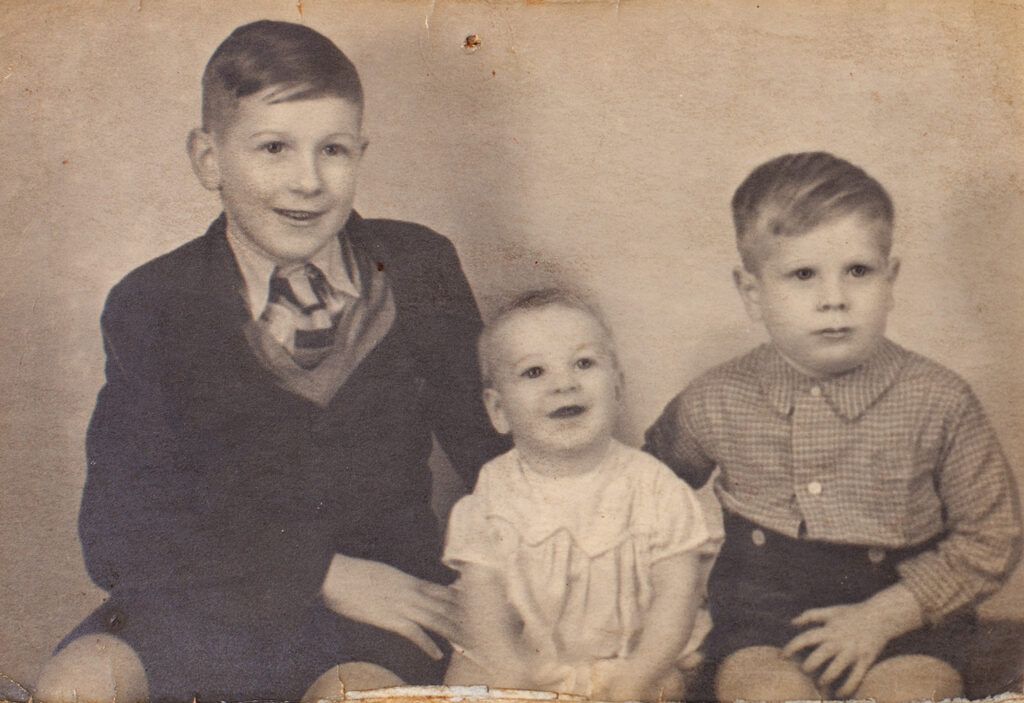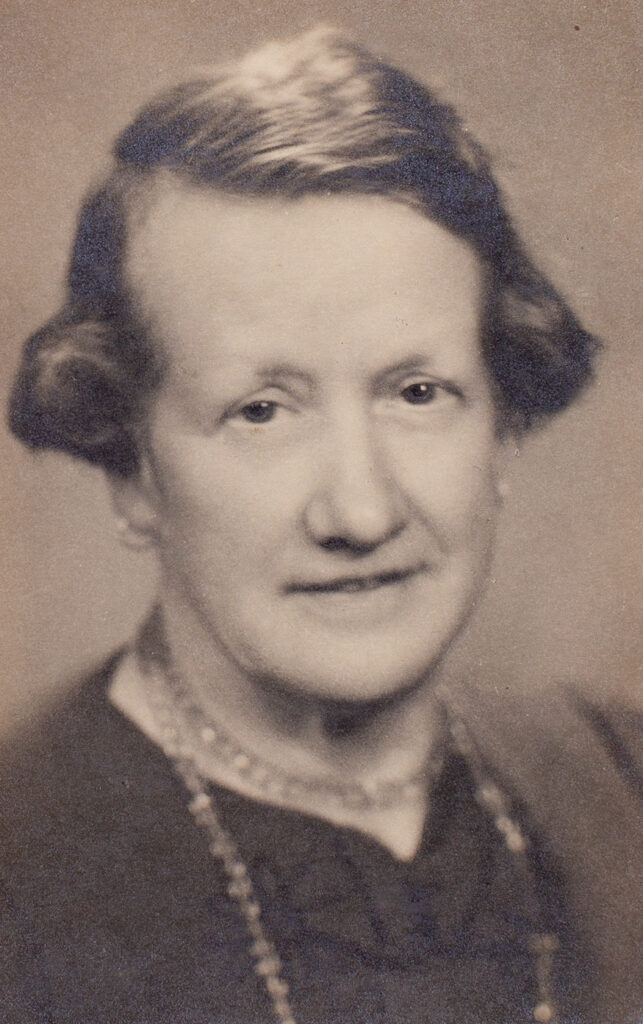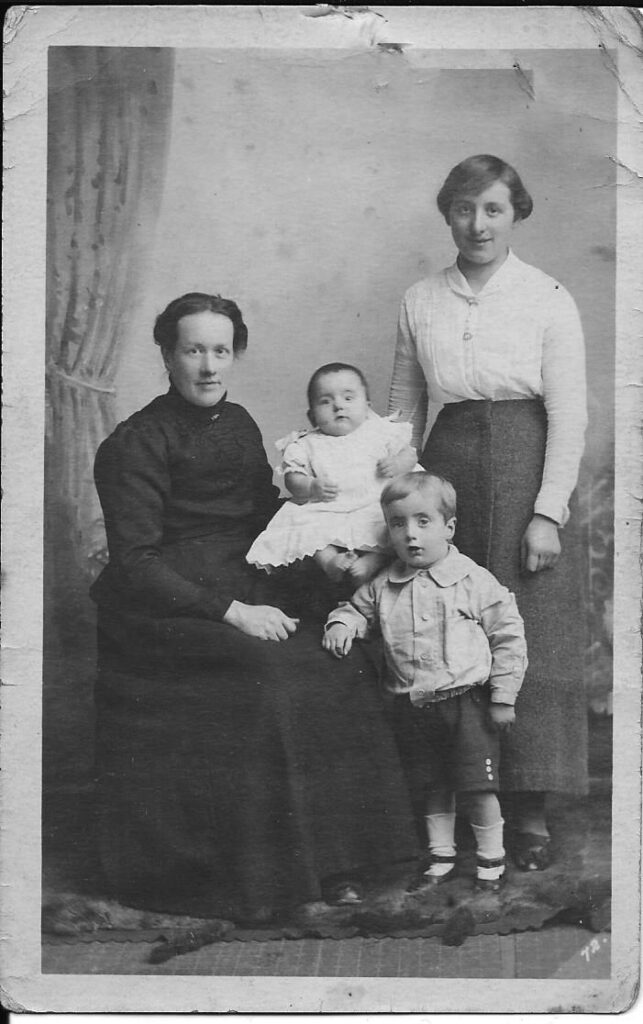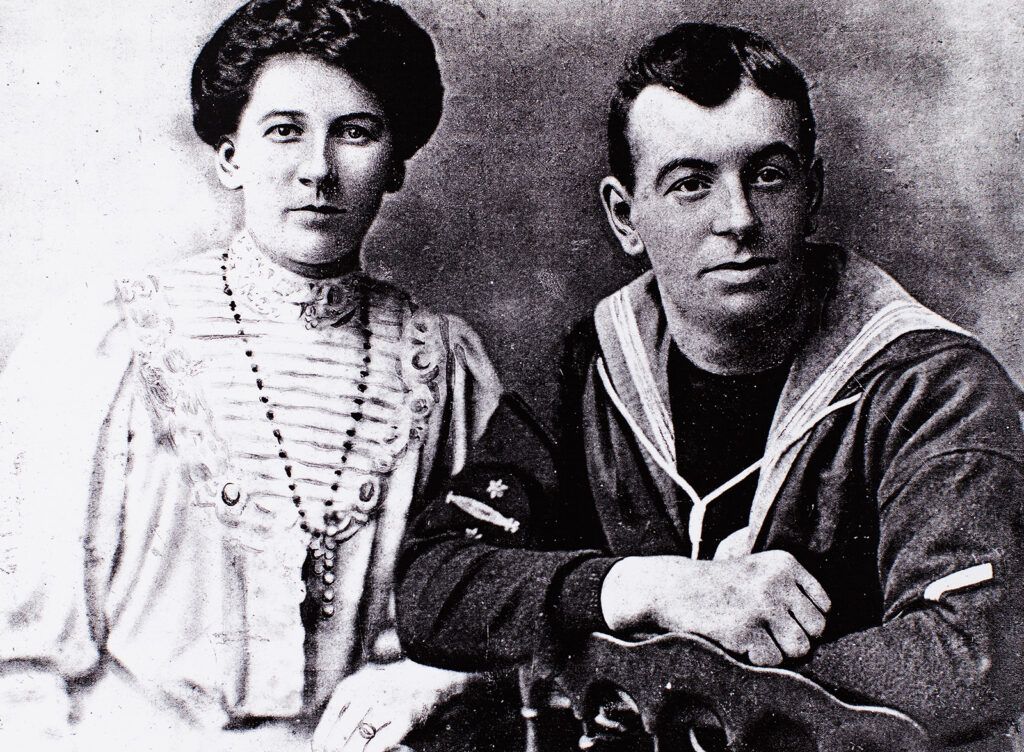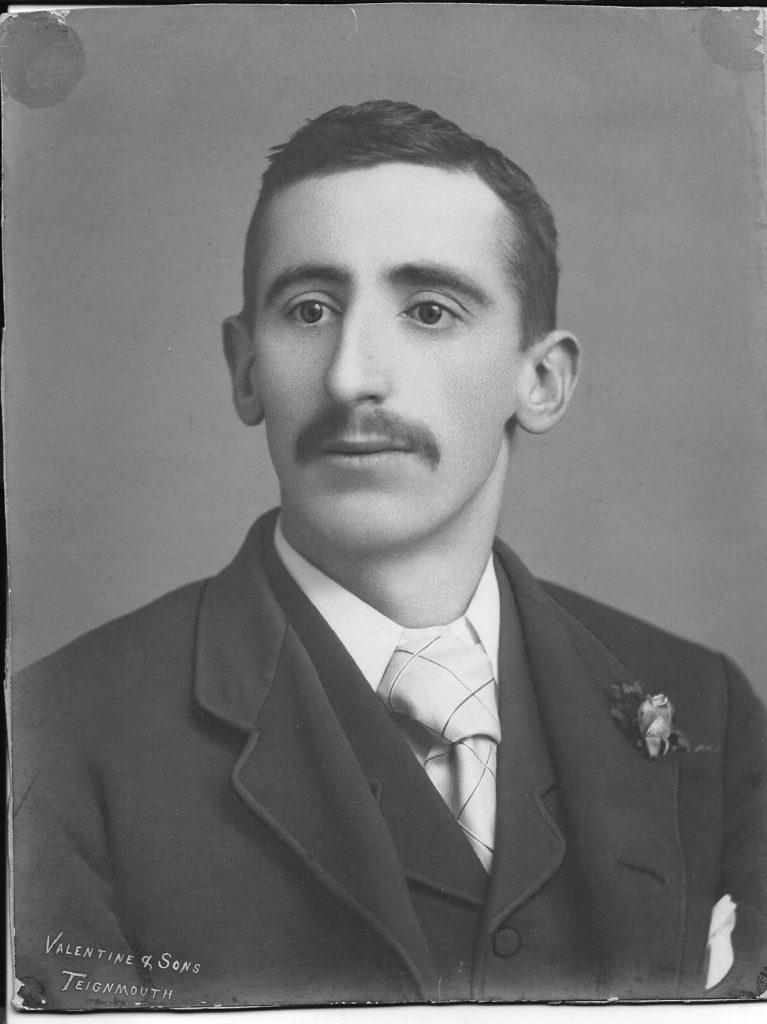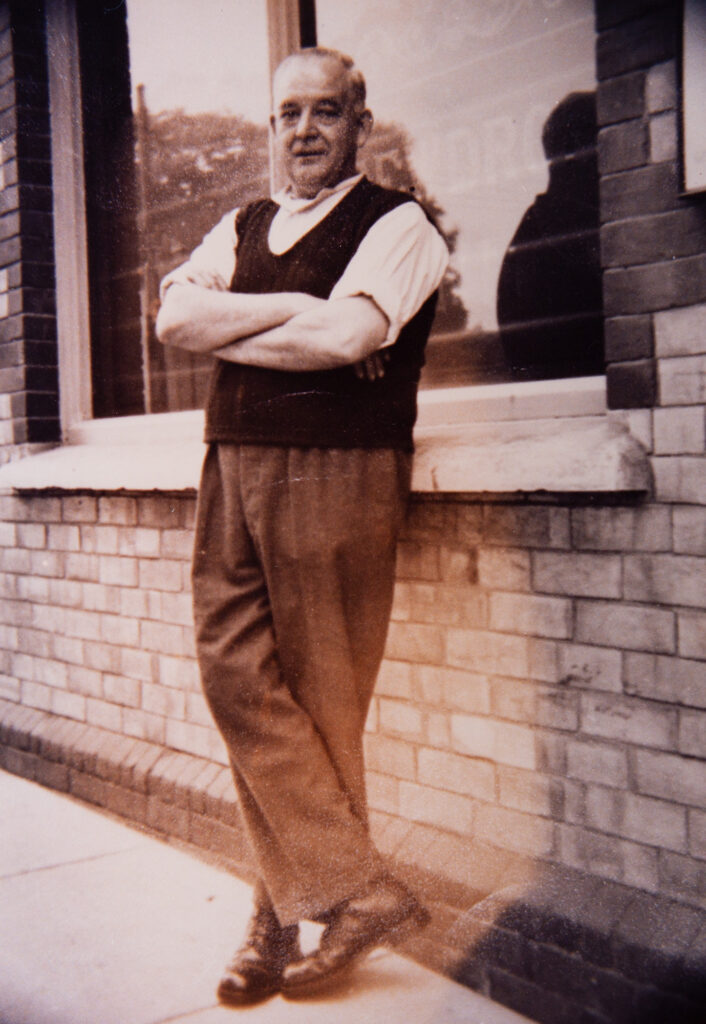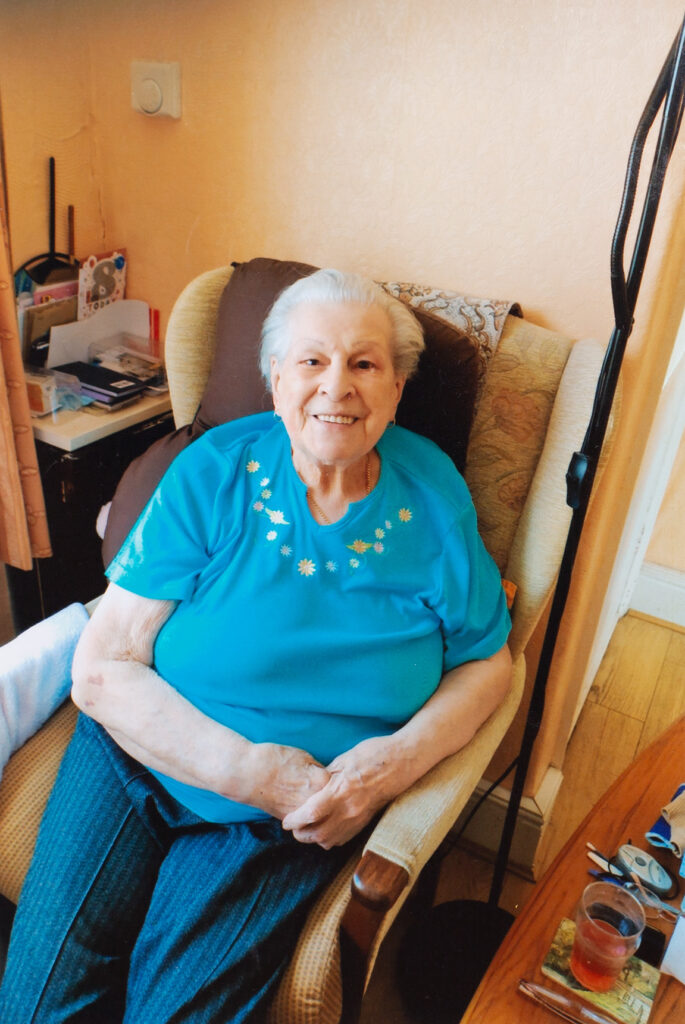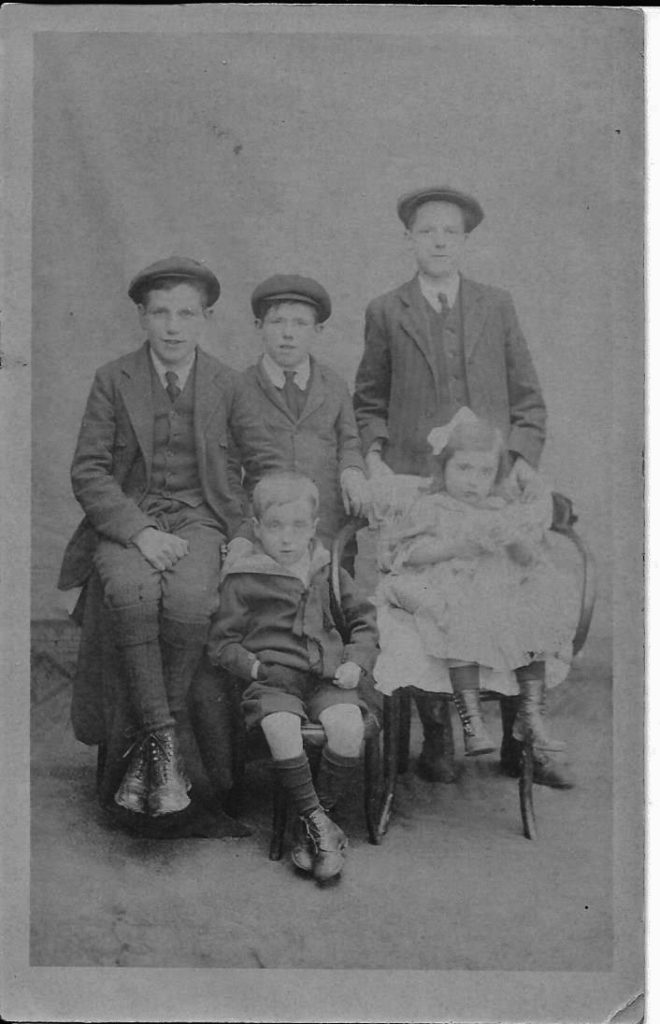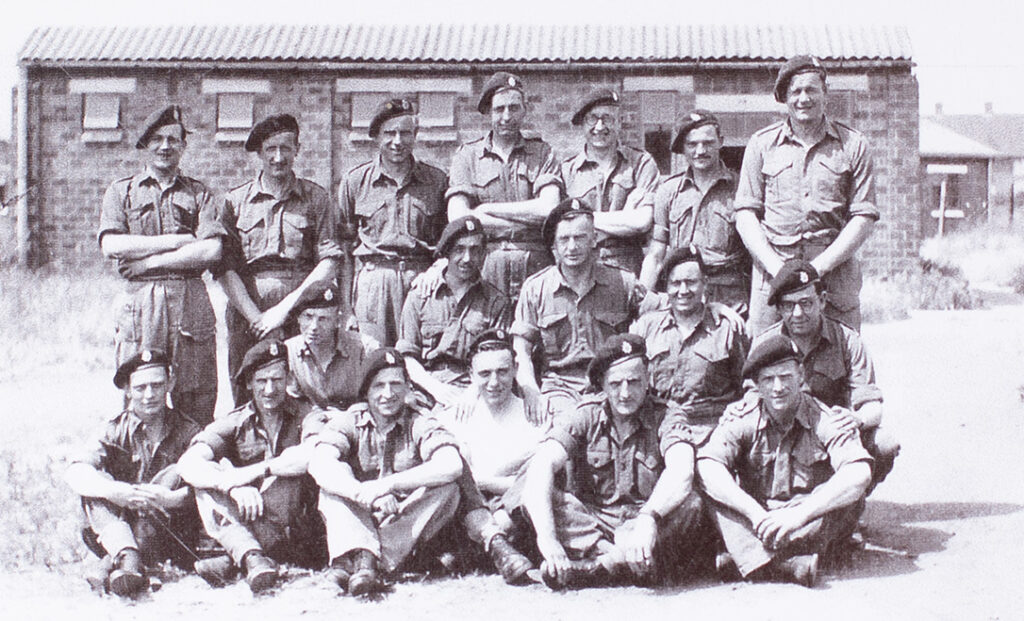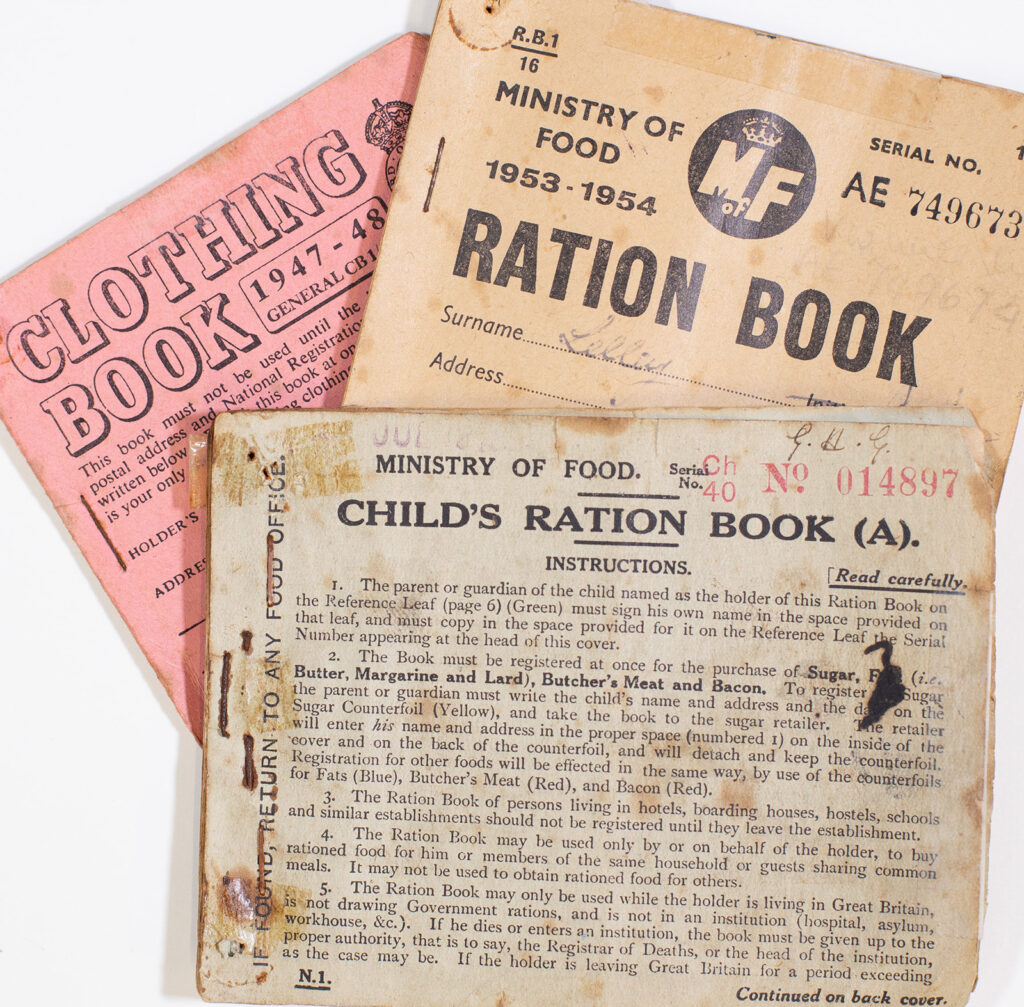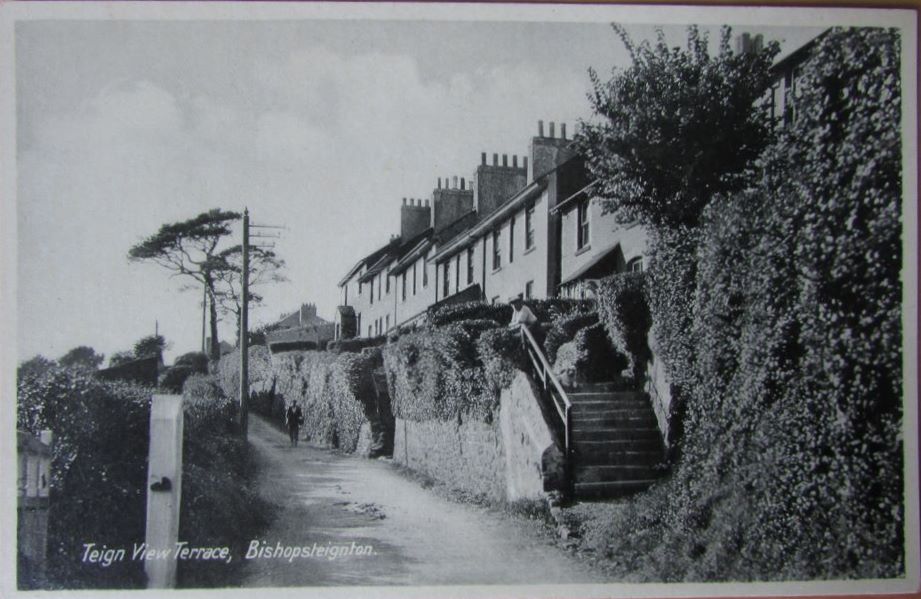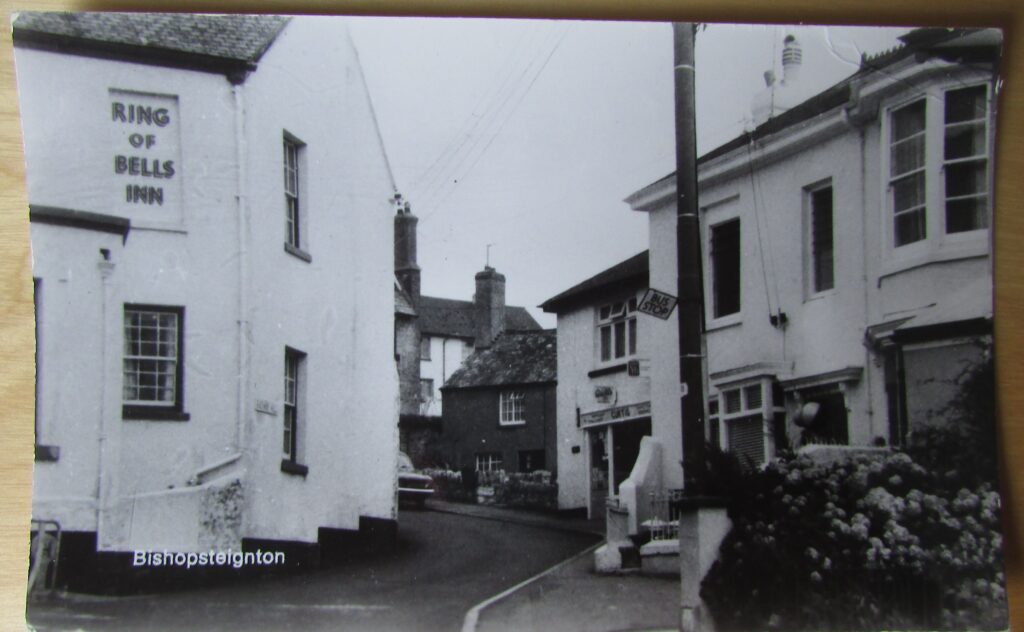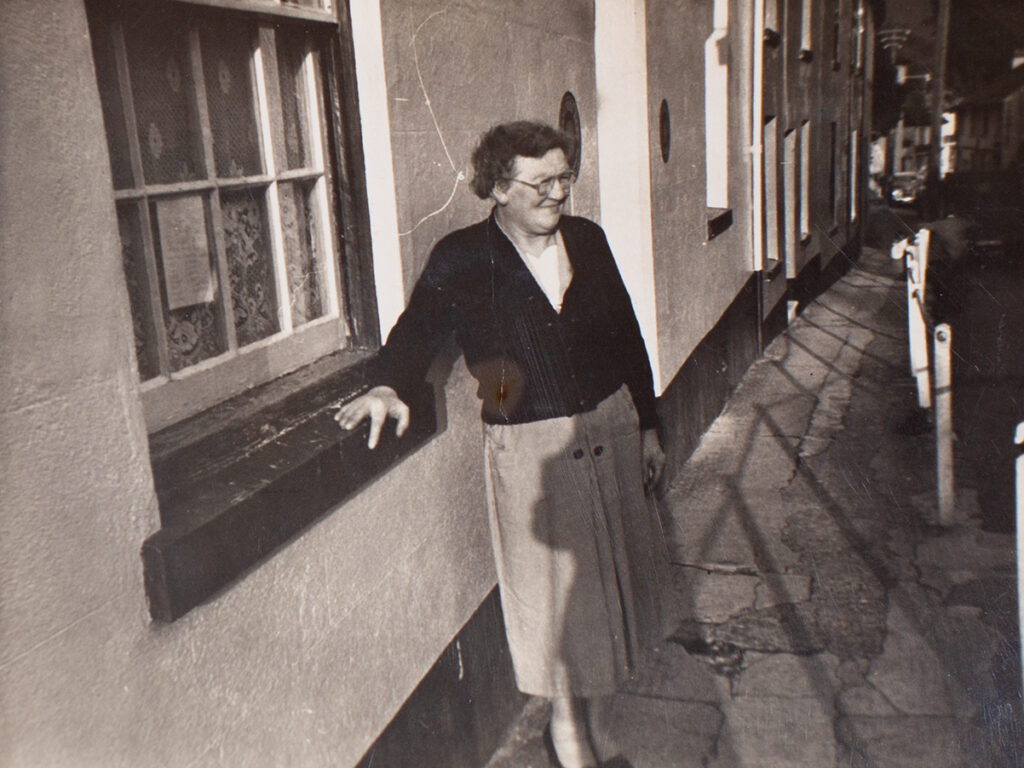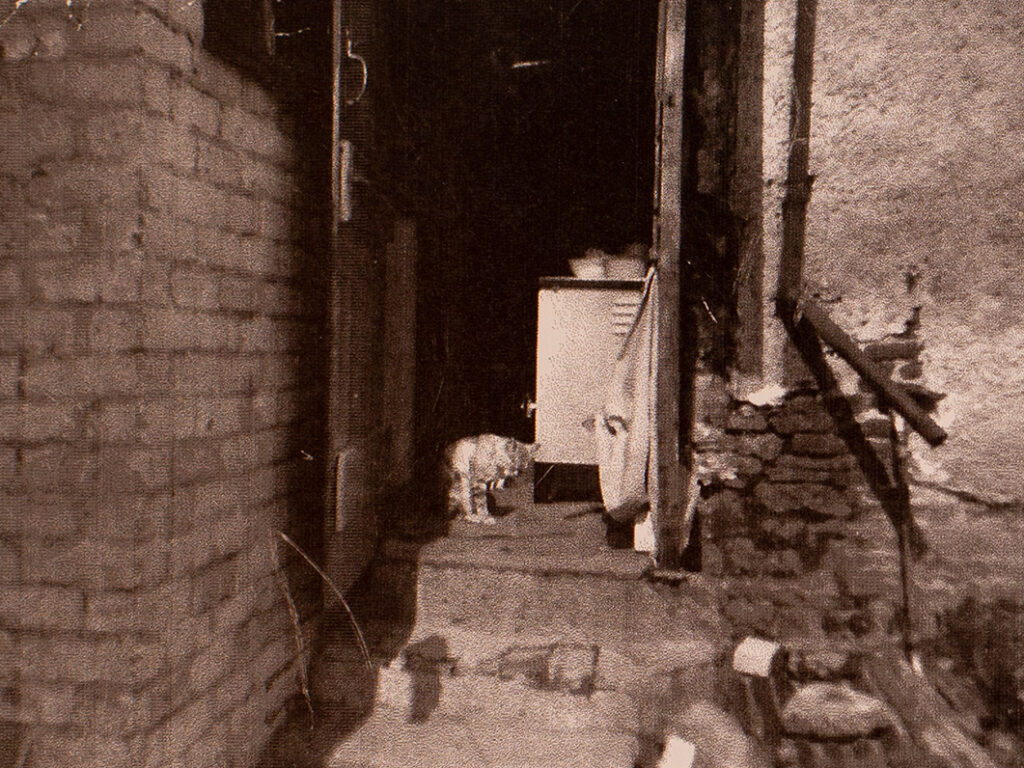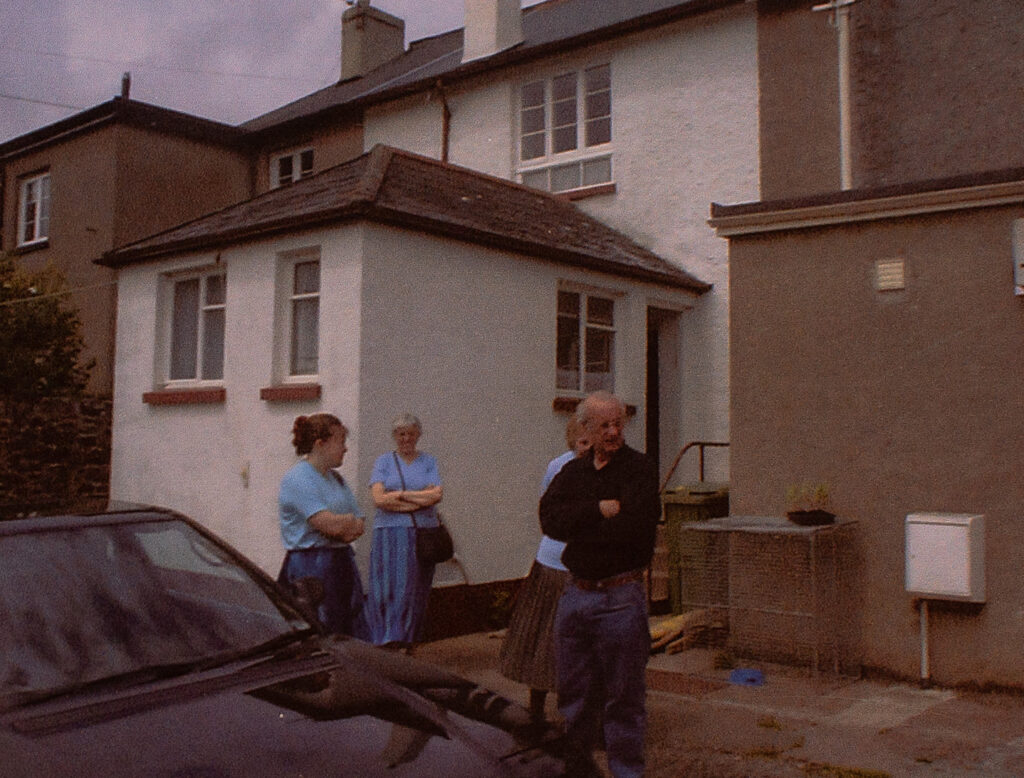Colin Back Born and Raised part 1 (17 minutes)
Being born and brought up in Bishopsteignton was a unique experience, I suppose partly because in those days there was nothing else to compare it with. I am Colin William Back. Son of William (Bill) Back (1913 – 1985) who was born at 9 Radway Hill, Bishopsteignton and Gwendoline (Gwen) nee Dennis (1910 – 1964) born in Kingsteignton.
My twin brother Paul and I were born 1944. Sadly, Paul did not survive outside the womb. There were three other brothers Dennis (1942 – 2021) and John (1945 – 2006) we four were all born at 27 Fore Street. My eldest brother David (1934 – 1977) was born at 7 Fore Street, above Garlands bakers. (No7 was then at the top of Fore Street. I am the only son left now.
Note: Fore Street originally started by the village hall going toward Huntley. When my parents moved to 27 Fore Street (circa 1935), this lower part was known as Post Office street.
My paternal grandmother Lavinia Mary Back (1876 – 1948) lived at 9 Radway Hill and raised 8 children there while at the same time working as a laundress from home. They had one ground floor living room that had a black-leaded stove. The kitchen was part of the passage from the front door to the back. This housed a coal and wood fired water boiler for the laundry. Upstairs were two bedrooms and a very cold attic. Outside loo and no bathroom.
My maternal grandmother Florence (Flo) Vallance (1885 – 1962) together with her second husband, Thomas (Tom) Vallance, moved from Kingsteignton to became the landlords of the ‘Manor Inn’ Post Office Street, (later to become Fore St.). My maternal grandfather Frederick George Dennis (1885 – 1914) (Florence’s first husband) died aged 29. He was one of the Royal Navy crew who sailed the submarine AE1 from England to Australia (first submarine in the Australian fleet).
Fredrick Dennis was on the AE1 which went down off Papua, New Guinea, 1915, where all hands were lost. Florence was left with three children under the age of five, Charles, Gwen (my mother) and Catherine (Kit). They had been ready to sail to Australia to join my grandfather. At Christmas 2018, 104 years after it disappeared, my cousin Roger, son of Charles, and I were sent news from Australia (via the AE1 descendants association): the AE1 had been found!
“It was incredible news and quite an emotional moment to receive photos of it in its final resting place.”
It was incredible news and quite an emotional moment to receive photos of it in its final resting place.
My grandfather John Back (1870 – 1918) died aged 47, a victim of the ‘Spanish Flu’ also known as the, 1918 pandemic. Two hundred and twenty eight thousand people died in Britain alone. He had been a gardener for the lovely Tapley Hotel.
Tom and Florence later had a daughter, Cynthia (Thora) (1928 – 1986) and an adopted daughter Barbara Dorothy Gertrude, always known as Pat (1927 – Jan 2022).
Both my parents lost their fathers at an early age, Dad at age four and Mum at age three. I was lucky; in being raised with family around me. My father had two brothers, a sister and their families, living in the village and a brother and family in Teignmouth. My mother’s sister Kit, married to Jack Ward, owned the butcher shop and lived next door to us before leaving England to live in America in the 50’s.
It was, frowned on to address married couples; older people or most over 21 from outside the family, by first names. It was always, Mr, Mrs, Miss, Aunt, Uncle, Grandad, Gran etc; a professional title e.g. Doctor or nurse or service title for a Major or Colonel; Sheila Robbins nee Skinner, was always Akela and Fred Pawlett was Scouty. Our teachers, the village police officer, vicars and other professionals all treated with the greatest respect not only by the children but also by the parents.
Within the village, even as a small child, one could feel that change was in the air. Menfolk were returning to their families following their war service, some having experienced worse conditions than others did.
Some children, who were only babies when their fathers were away in the national forces, had to get used to having a man as head of the household. Fathers seemed to have a stricter approach to family life. Some children had only known mum as being in charge. My younger brother and I went with my mother to Exeter army barracks to meet dad on the day of his discharge from the army. It was exciting yet bewildering. We had only seen dad when he had been on leave.
“At this time, most items were still on ration.”
At this time, most items were still on ration. Essential foods for example, meat, butter, tea, sugar and margarine, had been on ration since 1940 with clothes and even soap following soon after. The last to come off rationing in 1954 was meat, butter, cheese and fats. How mums managed in those days was incredible, they helped each other. As children; we were not given coffee or tea but I remember my father enjoying his cup of ‘CAMP’ Coffee, a chicory essence blend. Some of the mums were quite good at making their own small amount of butter and cream, being in the country there were a few who raised some chickens and eggs.
Sometimes we had ‘hand me down’ clothes, not just from the family but up and down the street as well. We were not proud, we were all in the same boat, and at least we had something different to wear. The clothes we grew out of were passed on to whoever needed them. My mother and a few others would go to the ‘jumble sales’ and buy up knitted articles for a few coppers, take them home, rip them out and wind the wool into skeins, wash them and use the wool to knit new articles. We always had new jumpers for Christmas.
Mum seemed to be always knitting, taking orders for the growing children of others. On occasions, my mother would knit in exchange for someone else sewing or helping in other ways. She knitted many new baby outfits free, to help new mothers to get started. As a youngster, I hated having to sit with skeins of wool hooked over open hands and stretched out between open arms while my mother wound the wool into balls. With all other articles it was a case of ’make do and mend’ whether it was a ripped sheet or holes in our socks (darning), lowering or taking up a hem or turning a shirt collar or cuff, there was a need for everything to last a little longer.
At the end of their purposeful life, articles became dishcloths, floor cloths, polishing cloths and dusters. Some white linen became boiling cloths in which to cook a steamed pudding. Coloured or patterned material became school gym or plimsoll bags. Buttons cut from old clothes went into a ‘button tin’ together with hook & eyes and reusable zips. Nothing was wasted.
“Nothing was wasted.”
We took shoes to Mr Dodd to for repair; he and his wife lived in the first house on Teign View Terrace. His workshop was right at the top of a steep garden. Mrs Dodd, a kindly lady would let me through the house to the garden. As one was leaving, back through the house, there was a biscuit waiting, often home cooked. Some old shoes that had to last the summer out before new ones were bought, for going back to school, had cardboard put inside to try to stop the wet and grit getting into the shoe, through holes in the soles !
Our village was made up four functioning churches and chapels plus one retired chapel building, seven farms, two butcher shops, four grocery shops, a chemist, three pubs, a greengrocer/newsagent, two garages, a post office, a wool shop, a baker (later became a fresh fish shop), two hotels, a café (later became a ladies hairdresser). Two Taxi services, three builder & decorator firms, a cobbler, a barber, a village bus service, a chimney sweep (who also doubled as the church graveyard caretaker), a clock & watch repairer, a resident district nurse a resident village policeman and a school with a head teacher who lived in the village. The residential being a mixture of many ‘Big Houses’, large houses and cottages and an important core of many smaller original village cottages.
It was great fun when the chimney sweep came, we watched intently as he added rod after rod to the brush head and eased it up the chimney. At a given signal from Mr Burgess, we children ran outside to watch for the brush to appear out of the top of the chimney pot. Once it was stuck halfway down, which did not please Mr Burgess but with a little manoeuvring, he soon got it loose followed by a pile of soot. The soot is to be used to feed the gardens.
It seemed to be fun when the chimney sweep came until I read the story ‘The Water Babies’ from which time, with a kids imagination of Mr Burgess sending us up the chimney, I was not so keen on hanging about.
A doctor’s surgery, (usually Dr Kelly from Teignmouth), took place twice a week and was held in the front room of (aunt) Dessa and (uncle) Sam Taylor, two doors down from the Manor Inn. There was also Dr Rosaleen Cooper who ran a surgery from her house on the Main Road (Newton Rd). On home visits, one would always see Dr Cooper accompanied by her wooden trug. She collected plant specimens and cuttings from her patient’s gardens. She introduced Dr Tuck to the village, as a partner, they initially worked from her house.
Once a week Dr Cooper with her housekeeper went country dancing in the village hall. The doctor employed me 1/6d for three hours to sit with, read to and feed her brother in law who was blind. I was about ten years old when I started. He was obviously well educated and gently spoken man, he had only recently lost his sight and really appreciated the time when he had someone to read to him and always praised my ability to read so well. I think it worked two ways, if I had not spent time with him, I would probably have never read some of the classics and listening to him increased my interest in social history.
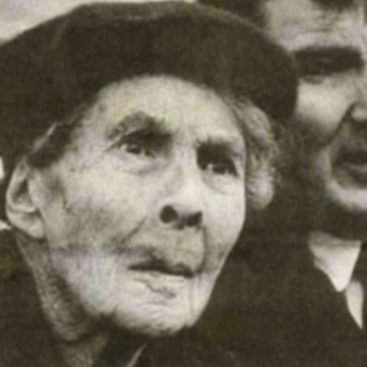
You can read more about Dr Rosaleen Cooper here.
A Bank also visited the village once a week and transactions took place in the front room of Mr & Mrs Harris, two doors up from the Central garage. We also had our regular post- man who delivered to the whole of Bishopsteignton on foot every day. He and his dog seemed to be there during all my growing up years.
“Most of the cottages and smaller homes had toilets outside.”
Most of the cottages and smaller homes had toilets outside. Some like ours was half way down the back yard. Several, like my grandmother’s home on Radway hill, shared a toilet with the neighbouring cottage, with a door each side.
Most homes had some sort of stand-alone boiler (gas or coal) to heat water for both laundry and baths. No central heating or running hot water. Mum boiled a kettle for us to have an ordinary wash and for dad’s shave. Some used either a communal or outside water pump. Baths were once a week, usually a Friday evening, ready for the weekend. A tin bath, brought in from outside and put in front of the fire. We all bathed in turn using the same water. From time to time mum would top up the water with a little extra hot.
After our bath, we were had a hot milk drink and were put to bed. Once we were settled, it was dad’s turn to have his bath in peace and quiet. We had a ‘bungalow bath’, which was galvanised, tapered and about five feet long. One had to be careful in the winter, as the side nearest the fire would get very hot. The bath usually hung outside and sometimes in the summer when the weather was hot, my mother would part fill it with cold water for us to play in.
In 1962, our old cob built kitchen; was demolished and replaced with a new kitchen, bathroom and toilet replaced the old building. A small coke fired boiler was built in the corner of the kitchen giving hot water for the bathroom and kitchen plus an airing cupboard. It was heaven though no central heating.
Colin’s reminiscences are continued in 6 more parts, visit Born and Raised in Bishopsteignton to read more.
Thank you to Colin Back for his stories and to Colin and Rowena Bradnam for the images.
This article was assembled by Dawn Rogers and the Bishopsteignton Heritage Hub team.
Being born and brought up in Bishopsteignton was a unique experience, I suppose partly because in those days there was nothing else to compare it with. I am Colin William Back. Son of William (Bill) Back (1913 – 1985) who was born at 9 Radway Hill, Bishopsteignton and Gwendoline (Gwen) nee Dennis (1910 – 1964) born in Kingsteignton.
My twin brother Paul and I were born 1944. Sadly, Paul did not survive outside the womb. There were three other brothers Dennis (1942 – 2021) and John (1945 – 2006) we four were all born at 27 Fore Street. My eldest brother David (1934 – 1977) was born at 7 Fore Street, above Garlands bakers. (No7 was then at the top of Fore Street. I am the only son left now.
Note: Fore Street originally started by the village hall going toward Huntley. When my parents moved to 27 Fore Street (circa 1935), this lower part was known as Post Office street.
My paternal grandmother Lavinia Mary Back (1876 – 1948) lived at 9 Radway Hill and raised 8 children there while at the same time working as a laundress from home. They had one ground floor living room that had a black-leaded stove. The kitchen was part of the passage from the front door to the back. This housed a coal and wood fired water boiler for the laundry. Upstairs were two bedrooms and a very cold attic. Outside loo and no bathroom.
My maternal grandmother Florence (Flo) Vallance (1885 – 1962) together with her second husband, Thomas (Tom) Vallance, moved from Kingsteignton to became the landlords of the ‘Manor Inn’ Post Office Street, (later to become Fore St.).
My maternal grandfather Frederick George Dennis (1885 – 1914) (Florence’s first husband) died aged 29. He was one of the Royal Navy crew who sailed the submarine AE1 from England to Australia (first submarine in the Australian fleet).
Fredrick Dennis was on the AE1 which went down off Papua, New Guinea, 1915, where all hands were lost. Florence was left with three children under the age of five, Charles, Gwen (my mother) and Catherine (Kit). They had been ready to sail to Australia to join my grandfather. At Christmas 2018, 104 years after it disappeared, my cousin Roger, son of Charles, and I were sent news from Australia (via the AE1 descendants association): the AE1 had been found!
It was incredible news and quite an emotional moment to receive photos of it in its final resting place. My grandfather John Back (1870 – 1918) died aged 47, a victim of the ‘Spanish Flu’ also known as the, 1918 pandemic. Two hundred and twenty eight thousand people died in Britain alone. He had been a gardener for the lovely Tapley Hotel.
Tom and Florence later had a daughter, Cynthia (Thora) (1928 – 1986) and an adopted daughter Barbara Dorothy Gertrude, always known as Pat (1927 – Jan 2022).
Both my parents lost their fathers at an early age, Dad at age four and Mum at age three. I was lucky; in being raised with family around me. My father had two brothers, a sister and their families, living in the village and a brother and family in Teignmouth. My mother’s sister Kit, married to Jack Ward, owned the butcher shop and lived next door to us before leaving England to live in America in the 50’s.
It was, frowned on to address married couples; older people or most over 21 from outside the family, by first names. It was always, Mr, Mrs, Miss, Aunt, Uncle, Grandad, Gran etc; a professional title e.g. Doctor or nurse or service title for a Major or Colonel; Sheila Robbins nee Skinner, was always Akela and Fred Pawlett was Scouty. Our teachers, the village police officer, vicars and other professionals all treated with the greatest respect not only by the children but also by the parents.
Within the village, even as a small child, one could feel that change was in the air. Menfolk were returning to their families following their war service, some having experienced worse conditions than others did.
Some children, who were only babies when their fathers were away in the national forces, had to get used to having a man as head of the household. Fathers seemed to have a stricter approach to family life. Some children had only known mum as being in charge. My younger brother and I went with my mother to Exeter army barracks to meet dad on the day of his discharge from the army. It was exciting yet bewildering. We had only seen dad when he had been on leave.
At this time, most items were still on ration. Essential foods for example, meat, butter, tea, sugar and margarine, had been on ration since 1940 with clothes and even soap following soon after. The last to come off rationing in 1954 was meat, butter, cheese and fats. How mums managed in those days was incredible, they helped each other. As children; we were not given coffee or tea but I remember my father enjoying his cup of ‘CAMP’ Coffee, a chicory essence blend. Some of the mums were quite good at making their own small amount of butter and cream, being in the country there were a few who raised some chickens and eggs.
Sometimes we had ‘hand me down’ clothes, not just from the family but up and down the street as well. We were not proud, we were all in the same boat, and at least we had something different to wear. The clothes we grew out of were passed on to whoever needed them. My mother and a few others would go to the ‘jumble sales’ and buy up knitted articles for a few coppers, take them home, rip them out and wind the wool into skeins, wash them and use the wool to knit new articles. We always had new jumpers for Christmas.
Mum seemed to be always knitting, taking orders for the growing children of others. On occasions, my mother would knit in exchange for someone else sewing or helping in other ways. She knitted many new baby outfits free, to help new mothers to get started. As a youngster, I hated having to sit with skeins of wool hooked over open hands and stretched out between open arms while my mother wound the wool into balls. With all other articles it was a case of ’make do and mend’ whether it was a ripped sheet or holes in our socks (darning), lowering or taking up a hem or turning a shirt collar or cuff, there was a need for everything to last a little longer.
At the end of their purposeful life, articles became dishcloths, floor cloths, polishing cloths and dusters. Some white linen became boiling cloths in which to cook a steamed pudding. Coloured or patterned material became school gym or plimsoll bags. Buttons cut from old clothes went into a ‘button tin’ together with hook & eyes and reusable zips. Nothing was wasted.
We took shoes to Mr Dodd to for repair; he and his wife lived in the first house on Teign View Terrace. His workshop was right at the top of a steep garden. Mrs Dodd, a kindly lady would let me through the house to the garden. As one was leaving, back through the house, there was a biscuit waiting, often home cooked. Some old shoes that had to last the summer out before new ones were bought, for going back to school, had cardboard put inside to try to stop the wet and grit getting into the shoe, through holes in the soles !
Our village was made up four functioning churches and chapels plus one retired chapel building, seven farms, two butcher shops, four grocery shops, a chemist, three pubs, a greengrocer/newsagent, two garages, a post office, a wool shop, a baker (later became a fresh fish shop), two hotels, a café (later became a ladies hairdresser). Two Taxi services, three builder & decorator firms, a cobbler, a barber, a village bus service, a chimney sweep (who also doubled as the church graveyard caretaker), a clock & watch repairer, a resident district nurse a resident village policeman and a school with a head teacher who lived in the village. The residential being a mixture of many ‘Big Houses’, large houses and cottages and an important core of many smaller original village cottages.
It was great fun when the chimney sweep came, we watched intently as he added rod after rod to the brush head and eased it up the chimney. At a given signal from Mr Burgess, we children ran outside to watch for the brush to appear out of the top of the chimney pot. Once it was stuck halfway down, which did not please Mr Burgess but with a little manoeuvring, he soon got it loose followed by a pile of soot. The soot is to be used to feed the gardens.
It seemed to be fun when the chimney sweep came until I read the story ‘The Water Babies’ from which time, with a kids imagination of Mr Burgess sending us up the chimney, I was not so keen on hanging about.
A doctor’s surgery, (usually Dr Kelly from Teignmouth), took place twice a week and was held in the front room of (aunt) Dessa and (uncle) Sam Taylor, two doors down from the Manor Inn. There was also Dr Rosaleen Cooper who ran a surgery from her house on the Main Road (Newton Rd). On home visits, one would always see Dr Cooper accompanied by her wooden trug. She collected plant specimens and cuttings from her patient’s gardens. She introduced Dr Tuck to the village, as a partner, they initially worked from her house.
Once a week Dr Cooper with her housekeeper went country dancing in the village hall. The doctor employed me 1/6d for three hours to sit with, read to and feed her brother in law who was blind. I was about ten years old when I started. He was obviously well educated and gently spoken man, he had only recently lost his sight and really appreciated the time when he had someone to read to him and always praised my ability to read so well. I think it worked two ways, if I had not spent time with him, I would probably have never read some of the classics and listening to him increased my interest in social history.

You can read more about Dr Rosaleen Cooper here.
A Bank also visited the village once a week and transactions took place in the front room of Mr & Mrs Harris, two doors up from the Central garage. We also had our regular post- man who delivered to the whole of Bishopsteignton on foot every day. He and his dog seemed to be there during all my growing up years.
Most of the cottages and smaller homes had toilets outside. Some like ours was half way down the back yard. Several, like my grandmother’s home on Radway hill, shared a toilet with the neighbouring cottage, with a door each side.
Most homes had some sort of stand-alone boiler (gas or coal) to heat water for both laundry and baths. No central heating or running hot water. Mum boiled a kettle for us to have an ordinary wash and for dad’s shave. Some used either a communal or outside water pump. Baths were once a week, usually a Friday evening, ready for the weekend. A tin bath, brought in from outside and put in front of the fire. We all bathed in turn using the same water. From time to time mum would top up the water with a little extra hot.
After our bath, we were had a hot milk drink and were put to bed. Once we were settled, it was dad’s turn to have his bath in peace and quiet. We had a ‘bungalow bath’, which was galvanised, tapered and about five feet long. One had to be careful in the winter, as the side nearest the fire would get very hot. The bath usually hung outside and sometimes in the summer when the weather was hot, my mother would part fill it with cold water for us to play in.
In 1962, our old cob built kitchen; was demolished and replaced with a new kitchen, bathroom and toilet replaced the old building. A small coke fired boiler was built in the corner of the kitchen giving hot water for the bathroom and kitchen plus an airing cupboard. It was heaven though no central heating.
Colin’s reminiscences are continued in 6 more parts, visit Born and Raised in Bishopsteignton to read more.
Thank you to Colin Back for his stories and to Colin and Rowena Bradnam for the images.
This article was assembled by Dawn Rogers and the Bishopsteignton Heritage Hub team.

